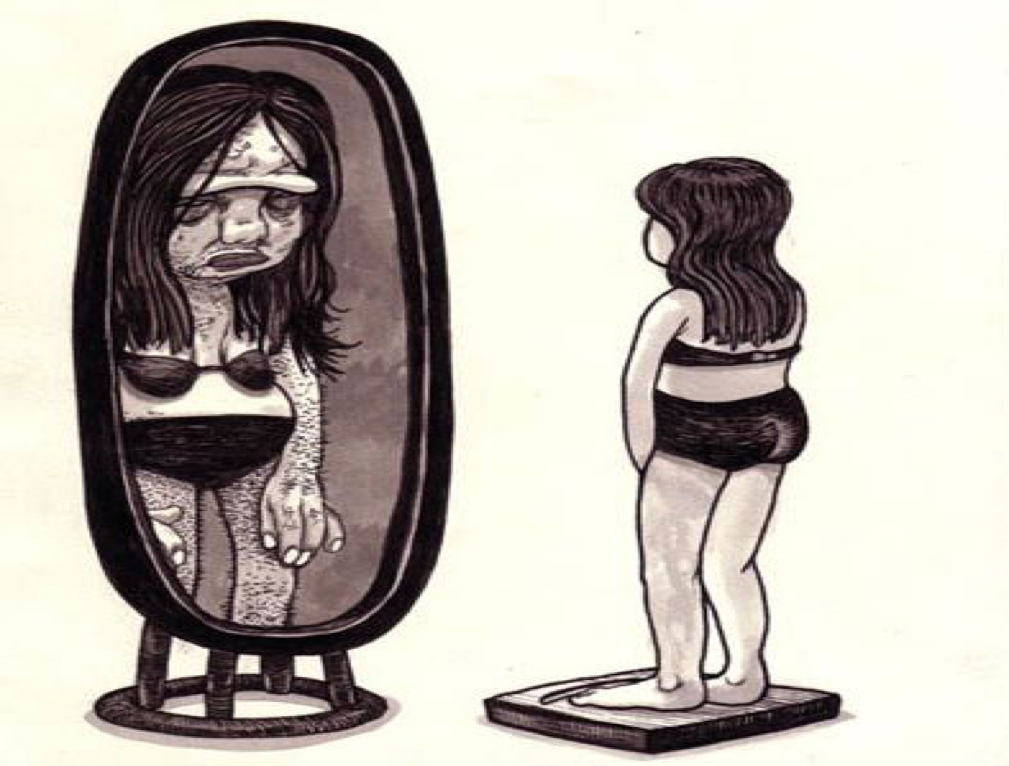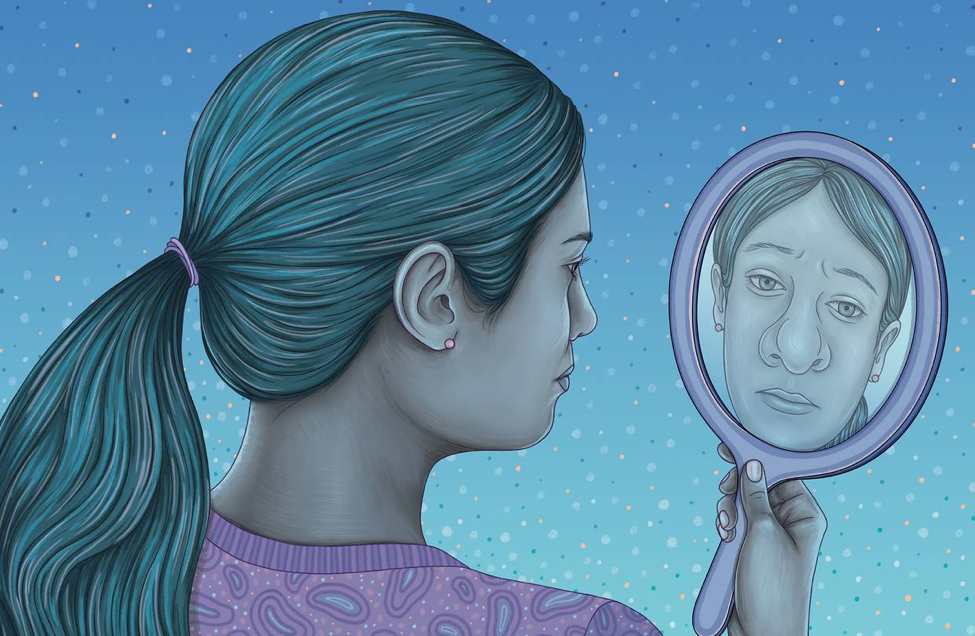We all have that one imperfection we wish we could change. It could be a crooked tooth, a large nose, acne-prone skin, and others. However, we accept it and carry on with our daily lives. It’s more of an annoyance than a debilitating thought. However, if you suffer from body dysmorphic disorder (BDD), you fixate on that imperfection. You are obsessed with that one imperfection, until it becomes the only thing you see. These obsessive thoughts can lead you to spend exorbitant amounts of time trying to conceal the flaw or seeking verbal approval of your looks. Even though, you are not likely to believe what people tell you.
The disorder usually first surfaces in adolescence and is characterized by obsessive thinking about a flaw. It may be hardly noticeable to the general population. BDD is also associated with spending lots of time in front of the mirror, engaging in behaviors to minimize the appearance of the perceived flaw, and hiding the disorder from others due to fear of social stigma.
Whereas most individuals might be annoyed by a real or imagined physical imperfection, if you are suffering from BDD you are likely spending hours a day obsessing over it. Some individuals may even undergo drastic plastic surgery to try to “fix” the flaw, usually with non-satisfactory results. The most common places you are likely to perceive a flaw if you are suffering from BDD is your hair, skin, stomach, nose, or chest. This list is not exhaustive and a perceived flaw can happen anywhere on the body.
Body dysmorphic disorder is similar to both obsessive-compulsive disorder (OCD) and eating disorders. However, it presents itself slightly differently. If you have an eating disorder, you are preoccupied with your overall weight and body shape, where if you suffer from body dysmorphic disorder, you are preoccupied with one specific body part. With OCD, you may suffer from recurrent thoughts, fears, or images you have no control over. The anxiety that results from these thoughts usually leads to the performance of rituals or routines, known as compulsions. When you have BDD, the obsession with the perceived flaw or defect leads to ritualistic behaviors (e.g., skin picking) and the obsession over the flaw leads to social, work, or home functioning impairment.

What are the Symptoms?
There are many signs and symptoms of body dysmorphic disorder and they widely vary from person to person. If you are suffering from BDD, you are likely spending an excessive amount of time obsessing over a perceived flaw on a specific body part. These are the compulsive behaviors to try to rid yourself of the defect.
If you are experiencing Body Dysmorphic Disorder, some of the most common body parts that you may fixate on are:
- Moles and freckles (especially related to their size – too large or too noticeable)
- Minor scars or aberrations
- Acne
- Facial and body hair
- Too little hair on head (e.g., balding or hair thinning)
- Size and shape of genitalia
- Size of breasts
- Muscle size (belief that the muscles are too small – also known as muscular dysmorphia)
- Size, shape, and/or symmetry of the face or another body part
Individuals with BDD are likely to exhibit one or many of the following behaviors or compulsions:
- Repetitive checking of a real or imagined flaw in the mirror
- Avoidance of mirrors
- Avoidance of having your picture taken
- Repetitive grooming activities (e.g., combing hair, shaving)
- Repetitive touching, checking, or measuring perceived flaw (minor or imagined)
- Wearing excessive makeup or growing a beard to cover up perceived flaw (minor or imagined)
- Wearing certain types of clothing (e.g., hats, scarves) to cover up perceived flaw (minor or imagined)
- Making multiple doctor visits, especially to dermatologists
- Undergoing multiple medical procedures (e.g., plastic surgeries) to try to eradicate or minimize the perceived flaw (minor or imagined) – usually resulting in unsatisfactory results
- Frequent thoughts about your appearance (hours per day)
Other behaviors may include:
- Repeatedly asking others for their verbal opinion of how you look (i.e., reassurance seeking) – not believing them when they say you look great
- Compulsive skin picking, using fingernails or tweezer to remove unwanted hair or blemishes
- Leaving the house less often or only going out at night to try to camouflage your appearance in the darkness
- Keeping obsessions and compulsions secret for fear of social stigma
- Emotional problems, including depression, feelings of disgust, low self-esteem, and anxiety
- Avoidance of social situations
- Belief that others take special notice of your perceived flaw in a negative way
- Excessive exercise
- Changing clothes frequently and excessively

Treatment
Psychological Treatment
Cognitive behavioral therapy (CBT) is a coping technique that teaches individuals suffering from body dysmorphia how to recognize irrational thoughts and change negative thinking patterns. You are taught how to take those negative thoughts and replace them with positive ones. In addition, exposure and response prevention are two key processes in CBT. Exposure helps individuals experiencing BDD confront situations that cause them to have irrational fears (e.g., going out in public with the perceived flaw uncovered). Response prevention teaches you how to resist the urge to cover up your perceived flaw with makeup or clothing, how to stop seeking reassurance from others about your appearance, and how to decrease the time you spend repeatedly checking your appearance.
Medications
Antidepressants, more specifically, selective serotonin reuptake inhibitors (SSRIs) can also be prescribed to individuals living with BDD as they help relieve the obsessive and compulsive thoughts and behaviors associated with the disorder. These are effective, in part, because it is believed that a partial cause of body dysmorphia are problems related to the brain chemical serotonin. Your doctor may prescribe you a gradual dose of antidepressants to make sure you tolerate the medication and the potential side effects. In some situations, you may also be prescribed an antipsychotic drug in addition to an antidepressant, especially if you are experiencing delusions related to your BDD diagnosis.
To get the most out of treatment, be sure to do the following:
- Don’t skip any therapy sessions, even if you don’t feel like talking.
- Take your medication as directed, even if you feel fine. There is a chance that your symptoms may return once you stop taking the medication and you could even experience withdrawal symptoms if you stop taking your medication suddenly.
- Educate yourself about your condition – learn all you can about the disorder and how it affects your body.
- Pay attention to warning signs and certain triggers that enhance your symptoms – speak about these with your therapist and doctor.
- Be more active – physical activity can help ease many of the symptoms associated with body dysmorphic disorder, including anxiety and depression.
- Avoid drugs and alcohol – they can interact with your medication and worsen mental illness symptoms.
- Do not skip regular, routine health checkups.

If you are suffering from BDD, you don’t have to suffer anymore. It would be helpful to seek help immediately with a therapist. To better accommodate your schedule, we have online counseling available with a therapist of your own choice. Schedule us online now!
Struggling with BDD? We can help.

